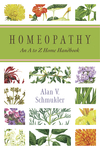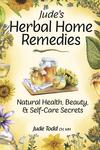Your Complete Homeopathic Handbook

Millions of people are suffering needlessly because they don't know about homeopathy, don't believe in it, or it isn't covered by their health insurance. This book is an effort to remedy that.
Homeopathy is the most comprehensive book on this subject ever written for the budding amateur. It takes the reader from basic theory and practice to using remedies for both common and life-threatening acute health problems. With brevity and clarity, it explains homeopathy, legitimizes it, and tells how to use it.
The book covers acute conditions that are either life threatening or painful, or could become so if not treated. It describes about 180 medical problems in plain terms, each description distilled into a single paragraph of the most useful information.
The reader can look up an ailment and match the symptoms with a remedy. I found that the average person who uses this method can consistently select the correct remedy for ailments ranging from measles to meningitis. The remedial profiles are carefully worded, to easily distinguish one from another. Since the reader is not trained in diagnosis, the book also explains how to find a remedy when you don't know the name of the ailment.
Conveniently arranged in alphabetical order, one finds such diverse topics as food poisoning; heart attack; stroke; cancer pain; mercury, lead, and arsenic poisoning; rabies; staphylococcus and streptococcus infections; gangrene and ailments from vaccination. Included are all the epidemic diseases, such as Anthrax, Cholera, Bubonic Plague, and virulent influenza; childhood diseases such as measles, mumps, chickenpox, scarlet fever and diphtheria are also covered. For each condition, the book offers remedies for both prevention and treatment, with a note that homeopathic remedies work even for antibiotic-resistant infections.
A chapter on pregnancy and birth covers topics from morning sickness to difficult labor, post-partum hemorrhage to newborn asphyxia. The reader may be surprised to learn that there are remedies for breach presentation, which can induce the baby to turn around.
Emotional states are given their due with remedies for grief, rage, depression, and a wide range of fears. Even acute psychoses are covered. In a crisis, such remedies are invaluable. They work quickly and without the drugging effects associated with pharmaceuticals.
The pain of various ailments is addressed throughout the book. For example, there are remedies for the pain of dental problems, gallbladder issues, stomach ulcers, neuralgia, and post-surgical pain. There is also a separate section devoted to different kinds of pain, including radiating, throbbing, wandering, and unbearable pain.
Whether your occupation is nursing, baking, tailoring, carpentry, farming, or firefighting, you’ll find remedies for yourself. About forty occupations and activities are listed with remedies for the relevant occupational hazards.
The chapter "Preventing Illness with Homeopathy" offers remedies to prevent twenty-seven diseases including Tetanus, Lyme, smallpox, Yellow Fever, Diptheria, and Malaria. This information will be especially useful when vaccines are in short supply, or for people who don't tolerate vaccines or prefer not to use them.
When an acute health problem is clearly associated with the liver, kidneys, heart or lungs, the reader can consult the section called "Organ Remedies."
Running low on remedies? The book also details how to make them last forever or make them from scratch. Aside from its everyday usefulness, this book will be a valuable asset when conventional medical care is either not available or not effective. In the next decade, the medical system could be temporarily overwhelmed by epidemics of antibiotic-resistant infections, natural disasters, outbreaks of exotic diseases, virulent flus, terrorist attacks, power failures, or mass illness arising from genetically-engineered food (now that the species barrier has been violated). This book will empower the average person to help him or herself in such a crisis. In addition, individuals with acute health problems who can't tolerate conventional medications and those who simply can't afford acute care will find this work extremely helpful.
To inspire the reader, the book details some of homeopathy's historical successes. During the epidemics of the nineteenth century, when death rates from typhus, plague or smallpox ranged from thirty to sixty percent, homeopaths routinely cured between 85 and 97% of their patients. The book also records homeopathy's achievements in preventing illness. In the 1974 meningitis epidemic in Brazil, 18,640 children were given a homeopathic remedy to prevent the disease. It was almost 100% effective. In a smallpox epidemic in Iowa in 1902, the homeopathic preventive remedy was 97% effective.
About Alan Schmukler
Related Products



is subject to certain Terms and Conditions